August 27, 2023. A massive protest took place outside of Gracie Mansion, the residence of the mayor of New York City, over the city’s plans to house a large influx of asylum seekers. Cuckoo News was on the ground, getting a firsthand look.

The populist working-class activist and former mayoral candidate Curtis Sliwa, founder of the community crime-fighting organization Guardian Angels, was at the center of the protest and was later arrested for disorderly conduct and obstructing government administration, along with several other people.




Billed as “We are the People Freedom Rally” – the protest was centered on the current migrant-asylum crisis in the United States. One of the main points of conflict is that Mayor Eric Adams has authorized several housing facilities to be made available for migrants at public expense, such as the recently converted Creedmoor Psychiatric Center in Queens and St. John Villa migrant shelter in Staten Island, among others. Some of the protesters demanded taking care of “our own citizens” and “homeless Americans” before migrants. Others, including Mr. Sliwa, challenged the mayor to open Gracie Mansion itself to the migrants instead.
Among the slogans chanted and/or displayed on placards, T-shirs, etc. were “America is Full” “Enough is Enough”; “Send them back”; “Close the Border”; “America First”; “USA”; and “Americans over Migrants”; along with many American flags. Someone chanting “f*ck Joe Biden” was also heard a few times.
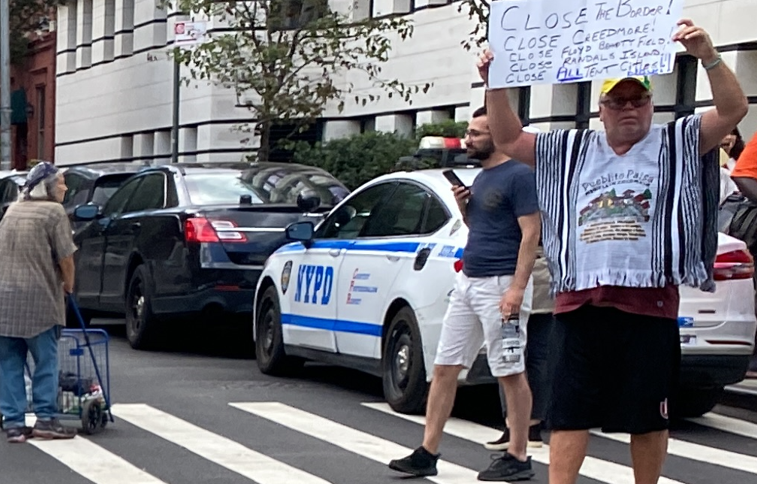

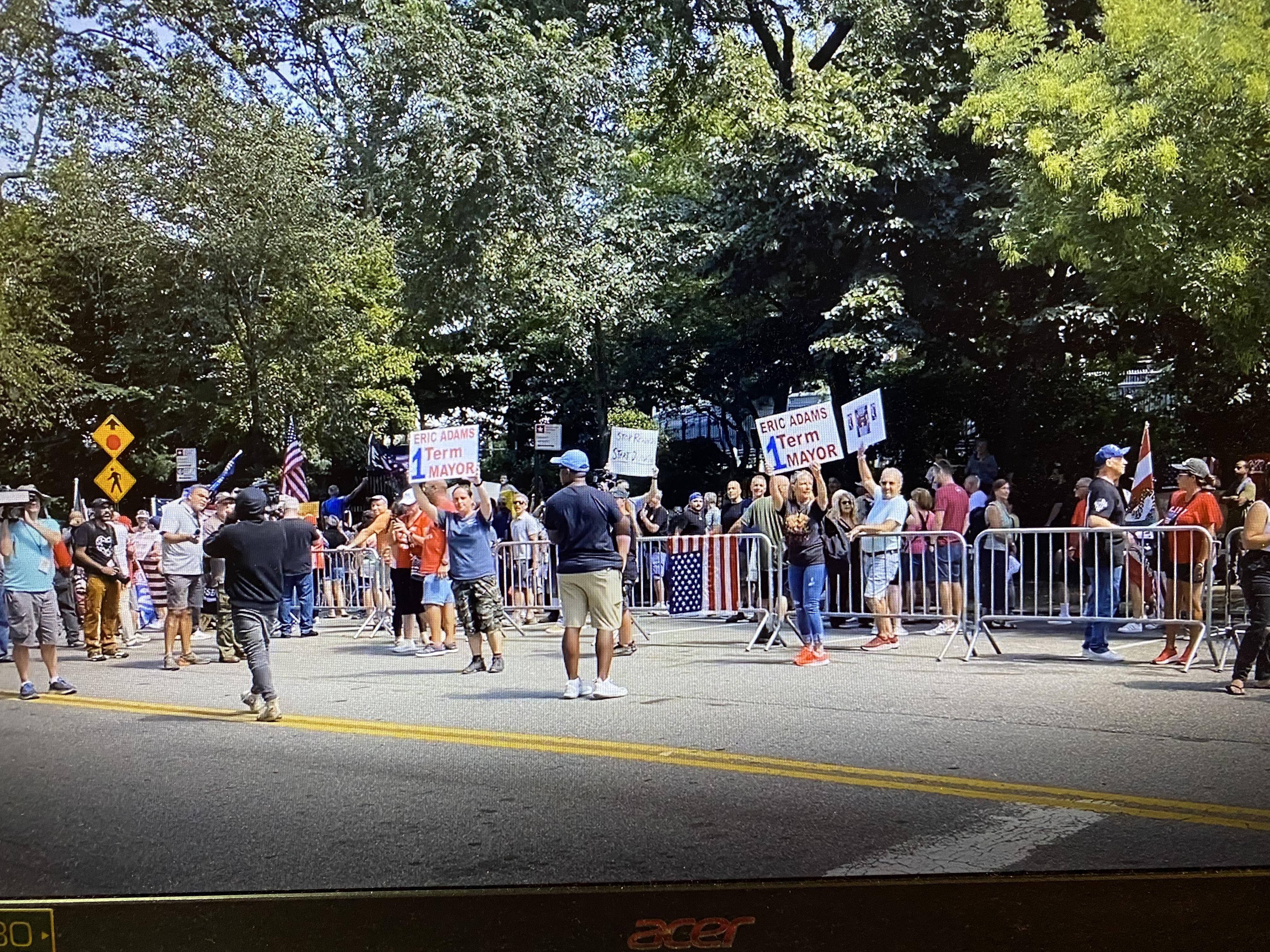
Chants and placards with many slogans. Photos by Koli Mitra.
We spotted two flags that piqued the curiosity. One of them was a big yellow Gadsden flag (with the famous slogan “Don’t Tread on Me”) that is associated with libertarians. Libertarian philosophy tends to support the free movement of people without interference from governments. So, one might expect the bearer of this flag to be a pro-immigrant counter-protester. However, there are many layers of complexity in the current circumstances. First, taxpayers are being forced to support the migrants—which is a violation of freedom and property rights, which libertarians will usually not tolerate. There are also some libertarians who, for practical reasons, make an exception to their general support for freedom of movement, although many of today’s self-styled libertarians often do not admit (or perhaps do not understand) that they are making an exception. Instead, they use tortured logic to find border enforcement as an “extension of property rights” (seemingly with none of their usual qualms about positing collective ownership without specific individual consent).

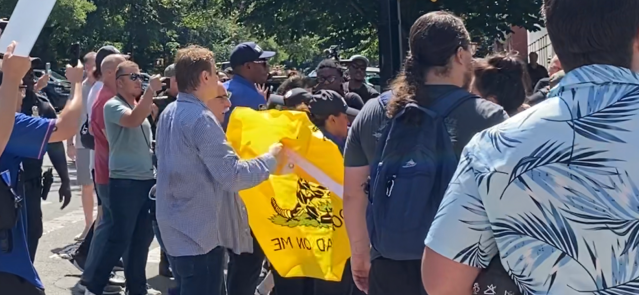
The other flag of interest was a giant rainbow flag with the words “Gays for Trump” which some casual observers might find surprising, but perhaps should not. Despite Trump’s more conservative base often being openly anti-LGBTQ rights, Trump himself was never really thought of as anti-gay before the early 2010s, when his hostility toward then-president Barack Obama led Trump to rebrand himself as socially conservative in order to curry favor with that segment of Obama’s adversaries. Even then, the details of his attitudes on specific issues don’t really suggest “anti-gay” the way they clearly do point to him being anti-immigrant (at least when the immigrants are Muslim or Latin American). As usual, political narratives tend to gloss over the fact that reality is messy.
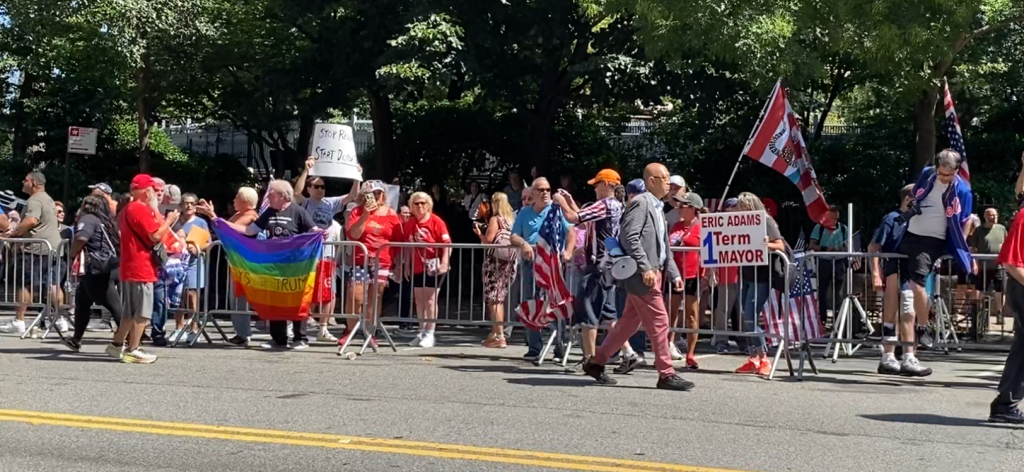
The rally was also attended by large numbers of counter-protesters, some of them shouting profanities and gesturing aggressively. Many of them were masked and black-clad, suggesting they might be associated with the leftwing activist group Antifa, whose adherents are well known for hostile and sometimes violent methods of protesting events that they perceive or characterize as conservative or rightwing. At this rally, when the main protesters chanted “send them back” some of the counter protesters responded with “suck my d*ck” without skipping a beat and chanting in the same staccato rhythm.



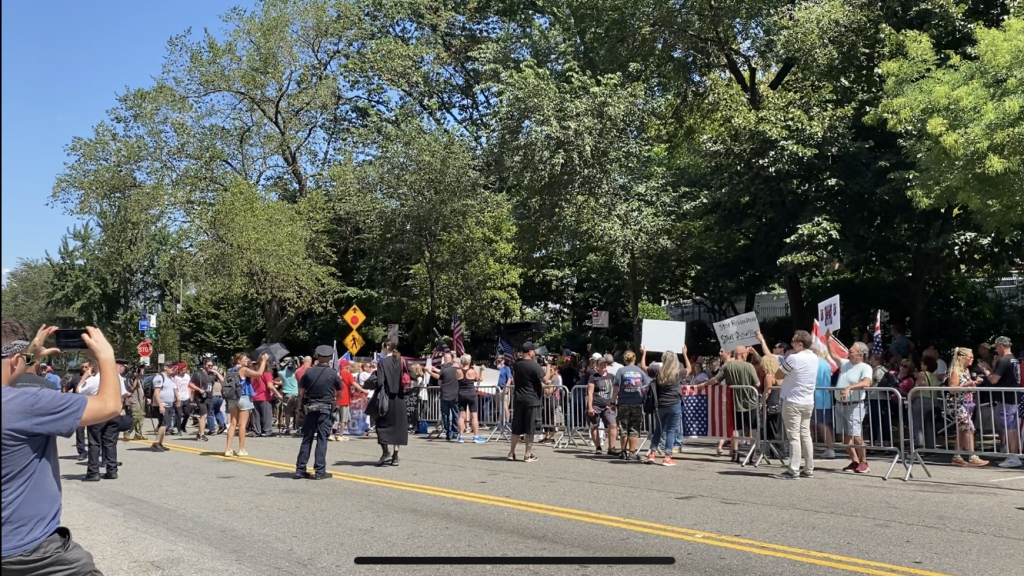
Tensions rise as counter protesters arrive to confront the anti-migrant protesters. Photos by Koli Mitra.
One man wearing a black “Rise and Resist” T-shirt made pointing motions toward the man holding the “Gays for Trump” flag and repeated in a sing-song voice “you’re daddy’s going to jail” (presumably referring to former president Donald Trump, who is currently facing several potential state and federal charges).


“Your daddy’s going to jail!” the “Rise and Resist” T-shirt man heckles the “Gays for Trump” banner man. Photos by Koli Mitra.
At some point, unsurprisingly, fighting broke out between the protesters and counter-protesters. Amid the violence, voices could be heard calling for “law and order” and for the police to “arrest the commie scum.”
Some pro-police sentiment was also heard, when a protest leader appreciatively reminded his comrades that “The police are here. It’s fine. The police are here.” In response, the crowd cheered and began to chant “N-Y-P-D! N-Y-P-D!” (New York Police Department).

New York City cops were on hand. “The police are here!” some of the anti-migrant protesters cheered, although by day’s end it would be some of their side getting arrested. Photo by Koli Mitra.
Protests like this are growing in frequency. There has been a slow-simmering and intermittently volatile migrant crisis in the U.S. for quite a while, spurred by various economic, political, and humanitarian disasters around the world throughout the 2010s. The pattern has been one of periodic spikes in migration and asylum seeking, followed by harsh crackdowns—including detention and deportations—by successive U.S. presidential administrations. But the current crisis is also fueled by certain unique contemporary factors. During the Covid-19 pandemic, the United States adopted a policy of severe restrictions on immigration and asylum approvals, under the authority of a federal statutory provision known popularly as Title 42 Expulsion. It is specifically Section 265 of Title 42 of the United States Statutes, which grants the president and the surgeon general certain powers to deny people entry into the U.S. based on concerns about the spread of contagious diseases. This power is not blanket or self-executing. The government must specifically announce the program and its detailed justification. However, once adopted, a program under this authorization can potentially last indefinitely. The Covid-19 based policy effectively suspended the usual rights that the U.S. laws give to asylum seekers and other migrants. Both the Trump and Biden administrations have applied the policy inconsistently, from a disease standpoint. Most recently, in Biden’s case, there has been a puzzling leniency with respect to asylum seekers from Ukraine but continued severity of restrictions against migrants from Central America. Given the differences in political situations and the migrants’ reasons for leaving their home countries, there may well be sound rationales for who is admitted and who is not. But such analysis is irrelevant to the use of a policy based on Section 265, which only authorizes restrictions based on the spread of diseases.
Despite being based on Covid-19 concerns, the policy continued to be enforced post-pandemic. At the same time, just south of the United States, Mexico relaxed restrictions at its own southern border, thus removing a longstanding de facto buffer between the United States (the most frequently chosen country to which people migrate) and some of the most troubled countries of Central America from which a sizable portion of the migrants have been fleeing. The combination of these factors had built up significant pressures, exacerbated by legal uncertainties in the U.S. following a judicial determination by a Washington D.C. federal court—and subsequently its temporary reversal by the U.S. Supreme Court—that the expulsions under the pandemic era policy were unlawful and impermissibly “arbitrary and capricious.”
A final trigger came on May 11, 2023, when the Biden administration lifted the restrictions, pegging the decision to an announcement that the Covid-19 related national emergency was officially over. The immediate aftermath of the decision brought in a flood of asylum seekers, many of whom have been waiting in a sort of limbo for some time.
While the debate rages on about the most sensible national policy on how to deal with people seeking entry into the United States, the reality right now is that hundreds of thousands have already entered, lawfully or otherwise. Cities all over the country are essentially being forced by the federal government to accommodate the migrants, mostly at the cities’ own cost or at the cost of the state where they are located. To make matters worse, these migrants have not been processed for work authorization, so they are not allowed to earn their keep. So, taxpayers are left footing the bill, a prospect that would be unpopular in the best of times but especially harshly greeted in the current climate, with an economy still devastated by the pandemic and lockdowns, buying power degenerated by inflation, high taxes supporting an array of deeply unpopular federal spending priorities—including a faraway war against the world’s other biggest nuclear power—to name just a few.
New York State Governor Kathy Hochul and New York City mayor Eric Adams, both Democrats, have complained loudly about this federal imposition on state and local resources by their own party and its leader, president Joe Biden. Mayor Adams in particular has expressed significant opposition. However, the protesters largely ignored such distinctions and registered their displeasure with the local Democrats, particularly the mayor. There were calls to “make Eric Adams a one-term mayor” for example. He is the least remote of the leadership and the one implementing the hated plans, and that’s bad enough to rankle the masses, even though it is clear upon even cursory reflection that he seems to be doing this reluctantly. I suspect more than a few of the protesters simply have not given it that reflection. Adams is a Democrat and this is a policy of a Democratic president. For a lot of people in the current polarized political climate, that’s enough to draw conclusions about their alignment on the issues.

The truth is, given the timeline of events, it is unlikely that lifting the Section 265 restriction is the Biden administration’s preferred policy at all. Legal pressure from courts and public pressure—including from some of the Democratic voter base—for consistency between the treatment of Ukrainian and Latin American migrants, along with other realpolitik-driven concerns probably did more to inform this policy change than any substantive interest in the outcome itself.
Indeed, as a historical note, Democrats tend to use pro-immigration rhetoric because large segments of their party are pro-immigration, but establishment Democrats (including the last three Democratic presidents), have acted rather like anti-immigrant hardliners without ever sounding like it. The most pro-immigrant presidents in the last half century have been the Republicans Ronald Reagan and George W. Bush, although their rhetoric was usually tempered in the other direction, given the propensities among large portions of their base. In other words—politics, like life, is messier than activists want to admit and more complicated than the media wants to deal with in this era of the 24-hour news cycle.
The Gracie Mansion protest illustrates this kind of lack of patience and nuance. For example, at one point one of the speakers complained “$383 a day for a migrant—I don’t even make that much per day!” referring to the estimated daily cost of putting up one migrant family in a hotel (the figure comes from a study by homeless advocacy group WIN, formerly a women’s homeless shelter named Women In Need). It is interesting to note, however, that the city housing planned by mayor Adams’s administration, which is the specific target of these protests—was devised to reduce that cost by no longer sheltering migrants in hotels.
Unfortunately, much of the anti-migrant rhetoric goes beyond the policy issues and targets the migrants themselves, painting them as lazy freeloaders who are imposing an unacceptable burden on hardworking taxpayers. In reality, most of these migrants want to work. But, as pointed out above, they are not legally allowed to work. Given a chance, these migrants will eagerly take work that most Americans are unwilling to do; they will pay taxes; they will contribute to the economy by working and buying things—the way all productive immigrants in all economies have done since the beginning of human commerce. A frequent anti-immigrant complaint is that asylum seekers are secretly “economic migrants” trying to enter the U.S. under the guise of a humanitarian emergency. What gets lost is the idea that “economic migrants” are precisely the type of people who are looking to become productive and economically solvent. Shouldn’t they be less of a strain on national resources (another common complaint of anti-immigration activists) than asylum seekers needing protection? In fact, isn’t “economic migrant” exactly the description that fits almost every wave of immigrants that famously “built this country?” If migrants were allowed to enter and given opportunities for productive work instead of taxpayer-supported living expenses, wouldn’t they cease to be a “burden” on existing Americans and become the next generation of immigrants to become American and help to continue building America so that it is never so “full” that it becomes stagnant?
Be sure to check out our video of some of the protest here.
Categories: Migrant Crisis, Politics, Zoom




